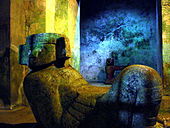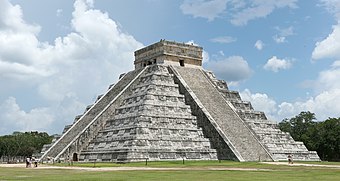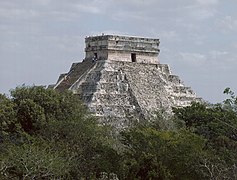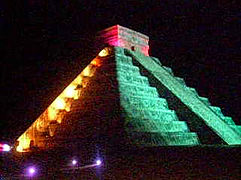Pyramid of Kukulcán
The pyramid of Kukulcán ( Kukulcán : Maya word for Quetzalcoatl ), also called El Castillo ('castle', 'fortress') by the Spanish conquerors , is a temple pyramid in the ruined city of Chichén Itzá in the north of the Yucatán peninsula ( Mexico ). The “younger pyramid” is visible, inside of which at least one previous building is hidden.
Younger temple pyramid
pyramid
The pyramid is 30 m high, has a base length of 55 m and rises in nine pyramid levels. The stairs on all four sides have 365 steps. This number is made up as follows: Three flights of stairs count 91 steps and the northern flight of stairs counts 92, gives 365. This calculation, which is supposed to refer to the days of the year, was already considered pure speculation by older authors. In fact, the number of steps is the result of the restoration campaigns - the north and west sides were restored by the Mexican Dirección de Antropología (from 1923 under José Reygadas Vértiz), the east side by the Instituto Nacional de Antropología e Historia (1979 under Peter J. Schmidt) ; the south side remained unrestored. The number of steps reached in this way varies between 91 and 93, if only because the terrain slopes slightly to the south.
The sides of the pyramid are nine-fold; the slightly sloping side surfaces of the steps are closed at the top by a horizontal band. Underneath - with the exception of the top step - there are four depending rectangular surfaces that are slightly set in front of the smooth outer surface of the steps. The corners of the steps are slightly rounded. Four stairs are in front of the core building; they are architecturally completely independent of this - the angle of inclination of both the pyramid and the stairs was therefore freely selectable.
temple
The temple building has an unusual floor plan: behind a wide entrance, which is the width of the temple, with two pillars in the form of snakes with bodies stretched backwards, which encircle the door beams, lies a smaller, almost square room whose cantilever vault is additionally supported by two pillars in order to be able to span the width of the room with two vaulted parts. A corridor leads around this room on three sides, which has doors to the three remaining stairs. The side surfaces of the doors are carved with life-size depictions of warriors in Toltec costume and armed with bundles of spears and spear throwers. The cornice above the doors of the temple protrudes clearly; this is followed by a setback and a second cornice, which protrudes a little further. Such a construction method that widens upwards is typical of the Puuc style - how much of this is due to the restorers remains uncertain.
Previous construction

Inside the pyramid there is an older, significantly lower structure with a similar floor plan (33 meters side length, 17 meters high up to the top platform); it also has nine pyramid steps, but only a single staircase on the north side with 61 steps and a temple with two rooms. In the anteroom is the sacrificial figure of a Chac Mool , who comes from the Toltec culture ; in the back room there is a red jaguar throne with applications of white and green stones. It is still unclear why both sculptures were left there when the old temple was abandoned.
The facade shows two vertically intertwined snakes above the entrance, similar to the west building of the Monjas complex in Uxmal ; on either side a procession of jaguars approaching the center, and between and above them oversized rosettes; these can also be found in the third volume of the four-part middle and upper cornices. The second band of the upper cornice shows an alternately inclined serrated rod , as is common in the late Puuc styles. The roof ridge above the front wall extends to just below the floor of the temple of the later pyramid.
The early pyramid is excellently preserved because of the sheathing by the later pyramid and was examined in the 1930s by J. Erosa Peniche using tunnel excavations, the associated staircase was not fully exposed until the 1950s. Inside the old temple pyramid there is apparently an even earlier construction, which, however, could not be further investigated.
Dating
The wooden door beams of the upper temple, which supported the doors and vaults in the interior of the late temple, were ideal for dating. There are only two early 14 C dates that gave calibrated mean values from 875 AD, with a statistical margin of error (2 sigma, probability of applying 95%) between 660 and 1050. The margin of error of these two dates makes the results overall rather unsuitable for dating the building. Since hieroglyphic inscriptions with dates of the Long Count are not available in this building, the temple pyramid visible today is dated 11th / 12th centuries. Century can be dated, while the previous building inside the 8th / 9th Seems to belong to the century.
Play of the feathered serpent
- For the pyramid of the feathered serpent see: → Xochicalco
Noteworthy is the "spectacle of the feathered snake", which can be admired every year on the equinox (March 20/21 and September 22/23) on the north side of the building: the shadow of the stepped and slightly beveled pyramid edges falls on the Sidewall of one of the stairs; this gives the impression that a snake is winding down there. Only the sides of the northern staircase consequently end in two stone snake heads; the other stairs don't have these heads. One can therefore assume that the builders of the pyramid were already aware of this phenomenon, and that they consistently worked towards it by choosing the different angles of inclination of the pyramid and staircase.
Building acoustic features
If you stand in front of one of the four stairs of the Kukulkán temple and clap your hands, you hear an echo that is very similar to the call of the Quetzal . Acoustics expert David Lubman investigated this phenomenon and came across other peculiarities: The steps of a person at the top of the stairs at the bottom of the stairs sound like falling raindrops. The echo of someone clapping in the middle of the ball court sounds like the roar of a jaguar .
Since both the jaguar and the quetzal bird were sacred animals and the rain in the form of the god Chaac was also sacred, Lubman concluded that these acoustic effects were deliberately taken into account in the construction.
Another special structural feature makes it possible to talk between two pyramid tips.
Others
The pyramid may no longer be climbed to ensure the preservation of the building; access to the early temple is also no longer permitted.
Kukulcán pyramid drawn by Frederick Catherwood (1843)
Web links
- The first sound designers in history: Maya architects once made the sacred bird Quetzal audible. In: Deutschlandfunk. November 16, 2010. (dradio.de)
- David Lubman: An archaeological study of chirped echo from the Mayan pyramid of Kukulkan at Chichen Itza. ( Memento from February 9, 2014 in the Internet Archive )
Individual evidence
- ^ Ignacio Marquina: Arquitectura prehispánica. 2nd edition. Instituto Nacional de Antropología e Historia, México, DF 1964, p. 849.
- ↑ E. Wyllys Andrews IV, E. Wyllys Andrews V: Excavations at Dzibilchaltun, Yucatan, Mexico. Middle American Research Institute, Tulane University, New Orleans 1980, OCLC 600931148 , Table 4.
- ↑ The first sound designers in history: Maya architects once made the sacred bird Quetzal audible. In: Deutschlandfunk. November 16, 2010. (dradio.de)
- ↑ ( page no longer available , search in web archives: pyramids of the Maya conceal acoustic secret )
Coordinates: 20 ° 40 ′ 58.6 ″ N , 88 ° 34 ′ 6.8 ″ W.







